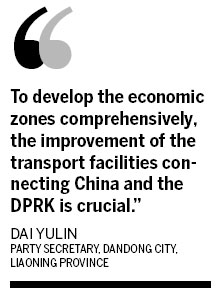|
A second economic zone will be located at the DPRK border city of Rajin-Sonbong (also known as Rason) near the Tumen River.
Bloomberg has reported that ground was broken on the initial stages of the project in June. Meanwhile, another undeveloped island called Wihwa, which is also close to Dandong, will be the site of the third zone.
"To develop the economic zones comprehensively, the improvement of the transport facilities connecting China and the DPRK is crucial," Dai of Dandong said.

Construction of a second road bridge linking the two countries has already started in Dandong and is scheduled for completion within the next three years.
The 6-kilometer, two-way bridge is expected to cost about 1.7 billion yuan. It will be paid for by China.
"The first bridge to be built over the Yalu River in more than half a century will be a major link between the two countries," Dai said.
The existing bridge was built in the 1930s and cannot cope with the increased volume of traffic that has resulted from the rising level of commercial exchange between the two countries, said Lu Chao, a researcher at the Liaoning Academy of Social Sciences.
Lu said the new bridge, 10 km downstream from the existing structure, will be linked to the Dongbiandao railway, which in turn will be connected to the Trans-Siberian Railway.
"It will be part of a railway network connecting the major countries in Northeast Asia," he said.
"Dandong is aiming to break through a lack of internal economic motivation and foreign investment as investors come in waves," Dai said.
He added that companies involved in sectors such as marine engineering, special steel, colored steel and automotive audio are expected to settle on Hwanggumpyong Island and Dandong city.
To boost trade with the DPRK, a tax-free zone of 10 sq km will also be set up in Dandong city, which has been included in the key development area of Liaoning Coastal Economic Zone, comprising an area of 192.86 sq km.
In Hunchun city, Jilin province, to which the special economic zone Rajin-Sonbong is very close, a maintenance project on the original bridge linking China and the DPRK is ongoing and will be completed this year.
"We are stepping up efforts to establish the infrastructure and transportation network, aiming to develop Hunchun and Rajin-Sonbong into a trade hub for several Northeast Asian countries," said Wang Xiaoping, head of the Tumen River Area Cooperation Division of the Jilin provincial government.
"Trade and investment in Rajin-Sonbong and Hunchun are at the heart of our ambitions to develop the Tumen River area," Wang said.
ROK's POSCO, the world's third largest steel maker, and SK Group, the fourth-largest conglomerate in the ROK, have both invested in Hunchun city.
The hinterland surrounding the Tumen River is one of the world's last great land-based resource frontiers, with reserves of oil, timber, coal, minerals and an abundance of farmland and fresh water.
"The booming bilateral trade between China and other Northeast Asian countries will help to promote trade within the community," Wang added.
According to China's General Administration of Customs, the value of direct exports to China from the DPRK last year was $1.2 billion, a 51 percent increase year-on-year, attributed to China's robust demand for iron ore, coal and copper.
At present, the DPRK mainly imports grain and oil from China. In 2010, China's exports to its peninsula neighbor reached $2.3 billion, an increase of 21 percent from a year earlier.
"Investors have seen vast business opportunities through the country's announcement about the development of the DPRK into a thriving nation by 2012," Wang said of the ambitious leader's plans.
|